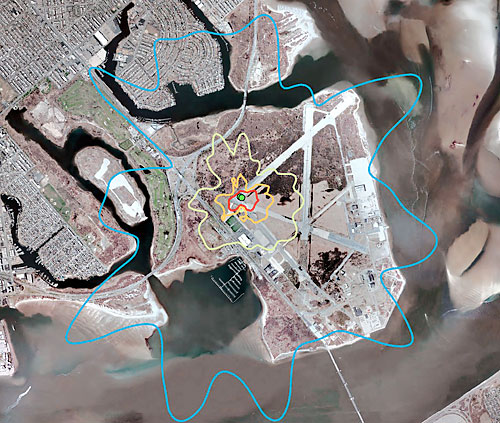Ladies and gentleman, Floyd Bennett Field is burning — no more!
Mill Basin and Marine Park residents can breathe easier now that the 24-hour debris burning at Floyd Bennett Field has been snuffed out as of Feb. 14, with the Army Corps of Engineers deciding not to renew its agreement with contractors operating the dual air-curtain burners, opting instead to use a super-sized vegetable grinder.
“Basically the contract for the burning was over, which is why we stopped,” said Army Corps of Engineers spokeswoman Marilyn Phipps. “It’s just that simple.”
The Army initially contracted with the incinerators for the disposal due to the difficulty in obtaining the industrial-grade grinder, according to Phipps, who described the machine as a “wood chipper on steroids.”
“It was a little bit slower getting the vegetation grinder in place than the air-curtain burners,” she said. “Some of the contractors responded more quickly and had the equipment on hand, while it took others a little longer.”
“There was so much debris after the hurricane, so we were looking at ways of quickly diminishing those piles.”
Vegetation grinders can reduce the debris into manageable piles more quickly than the incinerators, and the wood chips produced can be put to productive uses, according to Phipps.
“It’s faster than the incinerator, and the other thing is that the material from the grinders can be recycled,” the spokeswoman said.
There is currently about 45,000-cubic-yards of debris remaining at Floyd Bennett Field, and the Army is expecting a few thousand cubic-yards more of debris, plus 8,000 cubic yards of tree stumps to be chipped and carted off, according to Phipps.
The monster wood chipper may sound like a more efficient solution to the massive amount of debris generated by Hurricane Sandy, in regards to pollution, time-spent, and money saved, but that has not always been the city’s stance.
Due to fears of the ravenous Asian Longhorned Beetle — an invasive pest known to attack maple, elm, willow, birch, poplar, and ash trees, which could potentially devastate roughly half of the city’s five million trees — it was determined that the unwanted lumber had to be shredded twice. That would double the harmful emissions from the machines themselves, the “fugitive dust created by the shredding process,” and the trucks used to haul the mulch to its final destination, according to a variance memorandum sent from Department of Environmental Protection commissioner Carter Strickland to a contractor.
Environmental groups, however, are hailing the Army’s decision to snuff out the incinerators as a big win, citing federal Environmental Protection Agency studies, which found that the burners exceeded ambient air quality standards on Jan. 9, 28, 29, and on Feb. 5, according to the EPA’s website.
“The combustion of this debris led to high levels of particulate matter, a major lung irritant linked to asthma attacks, heart attacks and even premature death,” said Jeff Seyler, CEO of the American Lung Association of the Northeast. “We are glad that the city has given up on this misguided plan and that residents downwind can now continue rebuilding from Sandy without this additional air quality concern.”
Residents may or may not have faced serious health concerns from the debris incineration, but if they did, they weren’t complaining about it, according to Community Board 18 district manager Dorothy Turano.
“We haven’t gotten one complaint about the burners,” said Turano. “It could be that everybody is just numb after Hurricane Sandy, but I haven’t heard about anybody having problems with the burning.”
Reach reporter Colin Mixson at cmixson@cnglocal.com or by calling (718) 260-4514.























